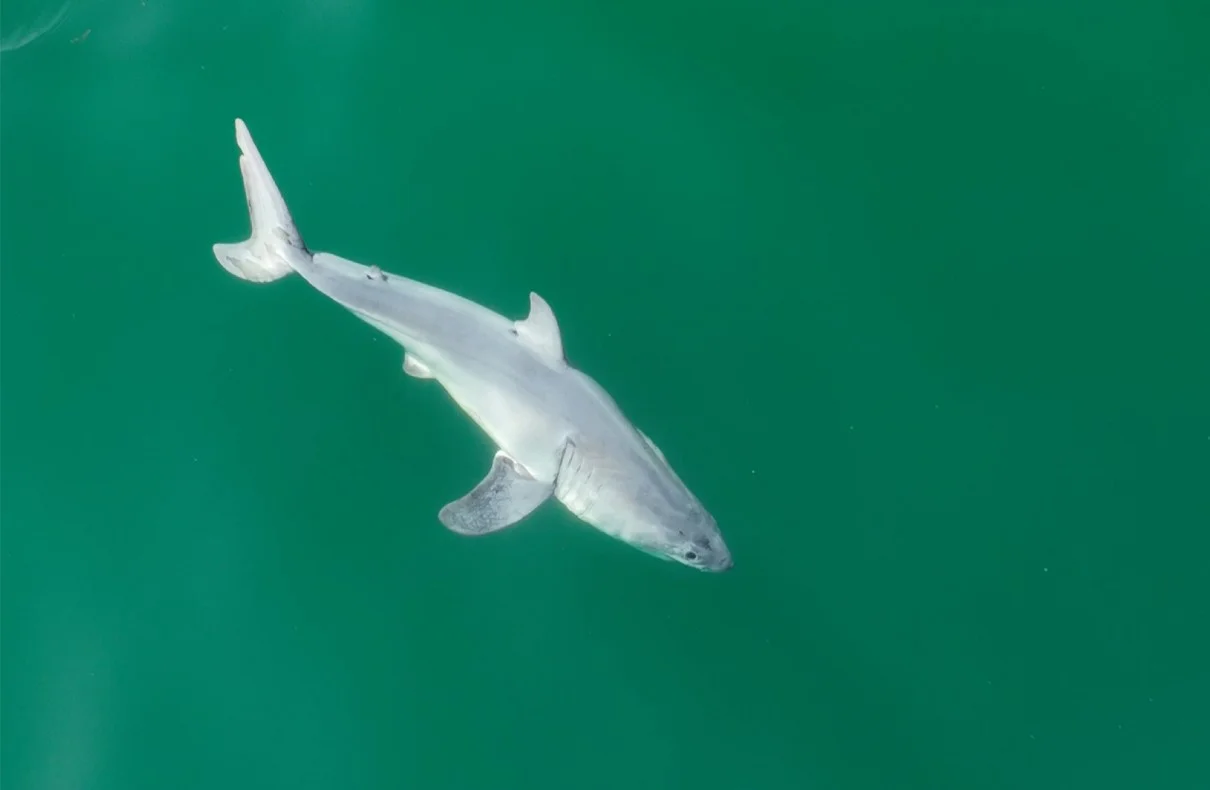
In the vast expanse of the ocean, great white sharks reign as one of the most formidable predators. These majestic creatures have captivated the imaginations of scientists and nature enthusiasts for decades.
In an unprecedented breakthrough, wildlife filmmaker Carlos Gauna and UC Riverside biology doctoral student Phillip Sternes stumbled upon what could be the world’s first glimpse of a newborn great white shark in the wild. Armed with drone cameras, they embarked on a mission to capture the secret lives of these elusive creatures off the coast of Santa Barbara, California.
After days of meticulous observation, Gauna and Sternes were rewarded with a sight that left them in awe. On July 9, 2023, they witnessed a 5-foot-long white pup swimming in the pristine waters. Its pale coloring and size immediately set it apart from its adult counterparts, sparking excitement and curiosity.
The birthing habits of great white sharks have long puzzled scientists. These apex predators have a gestation period of over a year, with mother sharks typically carrying two to ten pups at a time. While researchers knew that the embryos feed on unfertilized eggs within the mother’s body, the exact location and circumstances surrounding their birth remained unknown.
Woman Survives Shocking Shark Attack in Sydney’s Harbor
Gauna’s and Sternes’ discovery shed new light on the birthing process of great white sharks. As they examined the footage captured by their drone, they noticed a thin, white film enveloping the newborn shark, gradually sloughing off as it swam. This phenomenon led them to believe that they had witnessed the shedding of the shark’s embryonic layer.
The sighting of a newborn great white shark is a momentous occasion in the world of marine biology. Prior to this discovery, no one had ever observed a live newborn great white shark in the wild. The exact location of their birth remained elusive, leaving scientists with an unsolved puzzle.
According to Tobey Curtis, a shark scientist with the National Oceanic and Atmospheric Administration, the birthplace of great white sharks has always been a mystery. While young white sharks have been observed and studied in a few places, including southern California and Long Island, New York, the precise location of their birth remained unknown.
Gauna and Sternes’ finding brings researchers one step closer to unraveling the mystery of great white shark births. The observation of a newborn shark in Santa Barbara supports the hypothesis that this region serves as a birthing ground for these majestic creatures. If their assessment is correct, it marks a significant breakthrough in understanding the reproductive cycles of this endangered species.
The researchers believe that the milky white substance surrounding the newborn shark could be remnants of uterine milk, a nourishing secretion produced by the mother shark. This finding aligns with previous studies that suggest white sharks produce uterine milk to provide additional nourishment to their growing pups.
39 Year Old Man Dead After Shark Attack in Paia Bay
The discovery of a newborn great white shark holds immense significance for the field of marine biology. These apex predators play a crucial role in maintaining the balance of marine ecosystems. Understanding their reproductive habits and protecting their birthing grounds is vital for their preservation.
Gregory B. Skomal, Ph.D., senior fisheries scientist at the Massachusetts Division of Marine Fisheries, emphasizes the importance of the observation made by Gauna and Sternes. He praises their finding as a fascinating contribution to white shark reproductive biology and acknowledges that every bit of information gathered about these creatures is invaluable.
Great white sharks are listed as “vulnerable” worldwide and “critically endangered” in Europe on the IUCN Red List. The protection of their habitat and birthing grounds is essential for the survival of these magnificent creatures. Gauna and Sternes’ discovery highlights the need for lawmakers and conservationists to take action and ensure the preservation of these waters.
The researchers’ work is far from over. Their groundbreaking observation has opened doors to further exploration and understanding of the reproductive cycles of great white sharks. As they continue their investigations, Gauna and Sternes hope to capture more evidence and shed further light on the mysterious lives of these curious, calm, and calculating creatures.
